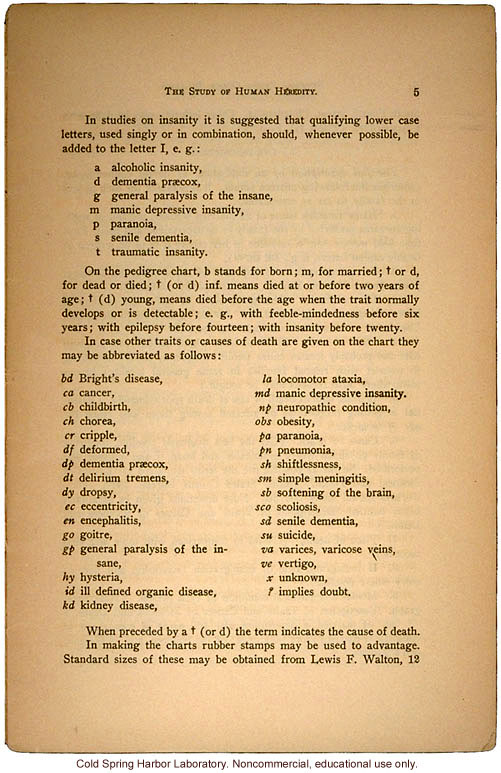The Study of Human Heredity 5
In studies on insanity it is suggested that qualifying lower case letters, used singly or in combinations, should, whenever possible, be added to the letter I, e.g.:
a alcoholic insanity,
d dementia praecox,
g general paralysis of the insane,
m manic depressive insanity,
p paranoia,
s senile dementia,
t traumatic insanity.
On the pedigree chart, b stands for born; m, for married; [dagger] or d, for dead or died; [dagger] (or d) inf. means died at or before two years of age; [dagger] (d) young, means died before the age when the trait normally develops or is detectable; e.g., with feeble-mindedness before six years; with epilepsy before fourteen; with insanity before twenty.
In case other traits or causes of death are given on the chart they may be abbreviated as follows:
[NOTE: All abbreviations below were set italic; their definitions were set roman]
bd Bright's disease,
ca cancer,
cb childbirth,
ch chorea,
cr cripple,
df deformed,
dp dementia praecox,
dt delirium tremens,
dy dropsy,
ec eccentricity,
en encephalitis,
go goiter,
gp general paralysis of the insane,
hy hysteria,
id ill defined organic disease,
kd kidney disease,
[broken into two columns here]
la locomotor ataxia,
md manic depressive insanity,
np neuropathic condition,
obs obesity,
pa paranoia,
pn pneumonia,
sh shiftlessness,
sm simple meningitis,
sb softening of the brain,
sco scoliosis,
sd senile dementia,
su suicide,
va varices, varicose veins,
ve vertigo,
x unknown,
? implies doubt.
When preceded by a [dagger] (or d) the term indicates the cause of death.
In making the charts rubber stamps may be used to advantage. Standard sized of these may be obtained from Lewis F. Walton, 12
[end]


